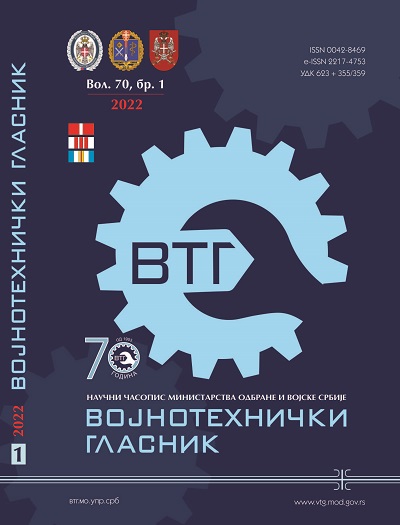Primena višekriterijumske optimizacije zasnovana na verovatnoći u tehnologiji materijala
Sažetak
Uvod/cilj: Iako postoji mnogo metoda za rešavanje problema selekcije materijala zasnovanih na aditivnim algoritmima, takvi algoritmi inherentno sadrže nedostatke i subjektivne faktore. Radi prevazilaženja slabosti pomenutih metoda, nedavno je razvijena višekriterijumska optimizacija zasnovana na verovatnoći koja uvodi novi koncept poželjne verovatnoće koji pokazuje stepen poželjnosti kandidata pri optimizaciji. U ovom radu koristi se nov metod za izvođenje optimalne šeme za materijal za kapacitivnu sklopku šanta u radiofrekvencijskim mikroelektromehaničkim sistemima (RF MEMS), za parametre sinterovanja prirodnog hidroksiapatita, kao i za optimalno projektovanje kandžaste spojnice.
Metode: Svi pokazatelji performansi korisnosti materijala – kandidata dele se na korisne i nekorisne za selekciju. Svaki pokazatelj performansi korisnosti kvantitativno doprinosi delimičnoj poželjnoj verovatnoći, dok proizvod svih delimičnih poželjnih verovatnoća čini ukupnu poželjnu verovatnoću kandidata, čime se problem višekriterijumske optimizacije prevodi u problem jednokriterijumske optimizacije i predstavlja jedinstveni odlučujući indeks u kompetitivnom procesu selekcije.
Rezultati: Bakar se pokazao kao odgovarajući materijal pri selekciji materijala za kapacitivne sklopke šanta u radiofrekvencijskim mikroelektromehaničkim sistemima (RF MEMS). Optimalni parametri sinterovanja prirodnog hidroksiapatita su 1100°C i nulti pritisak sabijanja, a optimalna šema za projektovanje kandžaste spojnice jeste šema broj 1.
Zaključak: Višekriterijumska optimizacija na bazi verovatnoće može se jednostavno primeniti za objektivno rešavanje optimalnog problema u tehnologiji materijala.
Reference
Abifarin, J.K. 2021 Taguchi grey relational analysis on the mechanical properties of natural hydroxyapatite: effect of sintering parameters. The International Journal of Advanced Manufacturing Technology, 117, pp.49-57. Available at: https://doi.org/10.1007/s00170-021-07288-9
Angira, M. & Rangra, K. 2015a. Design and investigation of a low insertion loss, broadband, enhanced self and hold down power RF-MEMS switch. Microsystem Technologies, 21(6), pp.1173-1178. Available at: https://doi.org/10.1007/s00542-014-2188-6
Angira, M. & Rangra, K. 2015b. Performance improvement of RF-MEMS capacitive switch via asymmetric structure design. Microsystem Technologies, 21(7), pp.1447-1452. Available at: https://doi.org/10.1007/s00542-014-2222-8
Ashby, M.F. 2000. Multi-Objective optimization in material design and selection. Acta Materialia, 48(1), pp.359-369. Available at: https://doi.org/10.1016/S1359-6454(99)00304-3
Ashby, M.F., Bréchet, Y.J.M., Cebon, D. & Salvo, L. 2004. Selection strategies for materials and processes. Materials & Design, 25(1), pp.51-67. Available at: https://doi.org/10.1016/S0261-3069(03)00159-6
Deshmukh, D. & Angira, M. 2019. Investigation on Switching Structure Material Selection for RF-MEMS Shunt Capacitive Switches Using Ashby, TOPSIS and VIKOR. Transactions on Electrical and Electronic Materials, 20, pp.181-188. Available at: https://doi.org/10.1007/s42341-018-00094-3
Podviezko, A. & Podvezko, V. 2015. Influence of data transformation on multicriteria evaluation result. Procedia Engineering, 122, pp.151-157. Available at: https://doi.org/10.1016/j.proeng.2015.10.019
Yan, Y., Fu, N., Zhang, X., Wang, C., Sun, J. & Lu, L. 2021. Research on the Multi-Objective Optimization Design of Connecting Claw Jig. International Journal of Steel Structures, 21(6), pp.1911-1920. Available at: https://doi.org/10.1007/s13296-021-00542-6
Yang, W-C., Chon, S-K., Choe, C-M. & Yang, J-Y. 2021. Materials selection method using TOPSIS with some popular normalization methods. Engineering Research Express, 3(1), art.number: 015020. Available at: https://doi.org/10.1088/2631-8695/abd5a7
Zheng, M., Wang, Y. & Teng, H. 2021. A New "Intersection" Method for Multi-Objective Optimization in Material Selection. Tehnički glasnik, 15(4), pp.562-568. Available at: https://doi.org/10.31803/tg-20210901142449
Vojnotehnički glasnik omogućava otvoreni pristup i, u skladu sa preporukom CEON-a, primenjuje Creative Commons odredbe o autorskim pravima:
Autori koji objavljuju u Vojnotehničkom glasniku pristaju na sledeće uslove:
- Autori zadržavaju autorska prava i pružaju časopisu pravo prvog objavljivanja rada i licenciraju ga Creative Commons licencom koja omogućava drugima da dele rad uz uslov navođenja autorstva i izvornog objavljivanja u ovom časopisu.
- Autori mogu izraditi zasebne, ugovorne aranžmane za neekskluzivnu distribuciju rada objavljenog u časopisu (npr. postavljanje u institucionalni repozitorijum ili objavljivanje u knjizi), uz navođenje da je rad izvorno objavljen u ovom časopisu.
- Autorima je dozvoljeno i podstiču se da postave objavljeni rad onlajn (npr. u institucionalnom repozitorijumu ili na svojim internet stranicama) pre i tokom postupka prijave priloga, s obzirom da takav postupak može voditi produktivnoj razmeni ideja i ranijoj i većoj citiranosti objavljenog rada (up. Efekat otvorenog pristupa).

